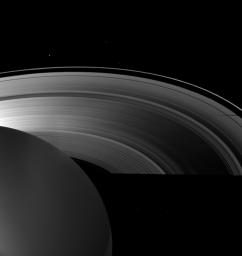Saturn's moon Tethys casts a shadow on the planet's A ring alongside the larger shadow cast by the planet itself in this image taken as Saturn approached its August 2009 equinox.
The night side of the planet is dimly lit here by ringshine. Tethys, located off to the left of this image, is not seen. The moon Janus (179 kilometers, or 111 miles across) can be seen orbiting outside the thin F ring at the top of the image. Other bright specks are background stars.
The novel illumination geometry created around the time of Saturn's August 2009 equinox allows moons orbiting in or near the plane of Saturn's equatorial rings to cast shadows onto the rings. These scenes are possible only during the few months before and after Saturn's equinox, which occurs only once in about 15 Earth years. To learn more about this special time and to see movies of moons' shadows moving across the rings, see PIA11651 and PIA11660.
The vertical brightness on the left of the image is lens flare, an artifact resulting from light being scattered within the camera optics. This view looks toward the unilluminated side of the rings from about 34 degrees above the ringplane.
The image was taken in visible light with the Cassini spacecraft wide-angle camera on June 19, 2009. The view was obtained at a distance of approximately 1.8 million kilometers (1.1 million miles) from Saturn and at a Sun-Saturn-spacecraft, or phase, angle of 116 degrees. Image scale is 105 kilometers (65 miles) per pixel.
The Cassini-Huygens mission is a cooperative project of NASA, the European Space Agency and the Italian Space Agency. The Jet Propulsion Laboratory, a division of the California Institute of Technology in Pasadena, manages the mission for NASA's Science Mission Directorate, Washington, D.C. The Cassini orbiter and its two onboard cameras were designed, developed and assembled at JPL. The imaging operations center is based at the Space Science Institute in Boulder, Colo.
For more information about the Cassini-Huygens mission visit http://saturn.jpl.nasa.gov/. The Cassini imaging team homepage is at http://ciclops.org.

 Planetary Data System
Planetary Data System












